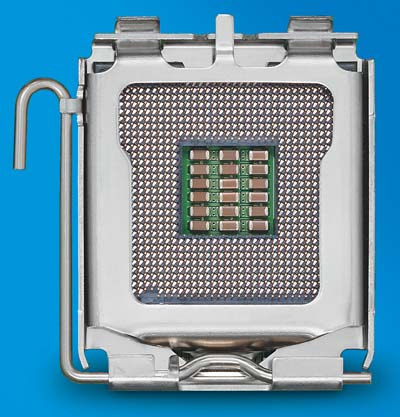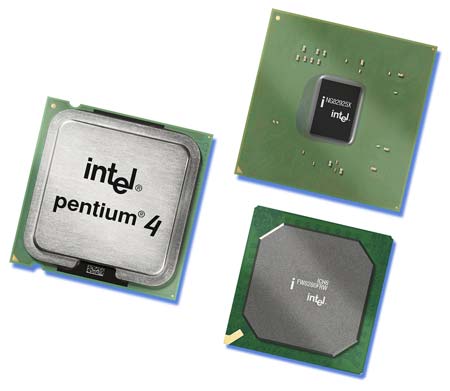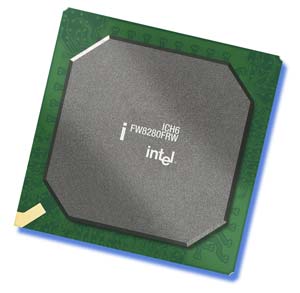Intel 925X/915: Chipset Performance & DDR2
by Wesley Fink on June 19, 2004 3:01 AM EST- Posted in
- CPUs
Intel Socket 775 Chipsets
You're looking at the new 775-pin socket T, which reverses the Socket 478 by putting the pins in the socket on the motherboard. The 775 processor has no pins at all; it has 775 small 'cups' that make contact with the pins in the socket.
The new chipsets for Socket 775 range from the 925X at the top to a full range of mainstream 915 chipsets, both with and without the new Intel Integrated DirectX 9 graphics.

The 915/925X are updates to the current 865/875 chipsets, which will continue in the Intel line for the time being.
All of the new 775 chipsets are paired with the updated ICH6 Southbridge. The ICH6 integrates the new 24-bit 192kHz High-Definition Audio. Intel HD audio also features eight independent DMA audio engines. This can enable multiple separate, simultaneous audio streams.

The new Southbridge also supports four SATA ports, which double the available SATA ports from ICH5. The new SATA ports can support either hard drives or optical devices with hot plug capabilities and Native Command Queuing (NCQ). While the SATA support is still SATA 1 (150MB/s), Intel claims that the new NCQ feature allows faster boots and increases file transfer speeds.
As we first saw on 875/865 family, there is also an ICH6R that can be paired with the new Northbridge chips to provide Intel Matrix RAID capabilities. The new Matrix Raid supports RAID 0, 1, 0+1, and an interesting option that allows combining both mirroring for security and striping for speed using only two drives.
New for 925X/915 is a new "W" Southbridge for ICH6 that supports Intel Wireless Connect Technology. This is designed to simplify wireless networks and connections. The W option is available with the regular Southbridge as ICH6W, and with the Matrix RAID version, ICH6RW. Consider the "W" in ICH6W and ICH6RW a future feature, however, because Intel does not yet have the wireless feature working. The accessory cards for wireless are not available at launch either.
The new Intel chipsets only support one IDE controller, so two IDE devices on the same channel is the only option for IDE. With SATA optical drives only just starting to appear, that means your IDE hard drive and optical IDE device will have to share a single channel. Even if you have SATA drives, your two IDE optical devices will have to share a single IDE channel. It is abundantly clear that Intel is trying to accelerate the move to SATA by limiting IDE options on the new chipsets.










57 Comments
View All Comments
Cygni - Saturday, June 19, 2004 - link
The three big "must upgrades", DDR2, BTX, and PCIe will offer little to no reason for people to switch over. This is one of those rare times where I say go ahead and spend. There really isnt anything much better on the immediate horizon. Get a nice high end P4 or A64 setup with the nicest vid card you can find and enjoy. All the new tech is useless.On the 925/915 itself, the high quality audio, upped integrated graphics, and 4 SATA ports are all good things for sure. Im waiting to see how the audio and graphics perform. Could be a future super-platform for low end computers.
JustAnAverageGuy - Saturday, June 19, 2004 - link
#4You're probably right.
Would have been a much fairer comparison had they used the same CPU.
A Northwood on 875
vs a
Prescott on 925
hardly compares the chipsets.
A prescott on 875
vs a
Prescott on 925
probably would have been a bit more objective.
JustAnAverageGuy - Saturday, June 19, 2004 - link
Is that a typo on page 19?Second graph
http://www.anandtech.com/chipsets/showdoc.html?i=2...
rjm55 - Saturday, June 19, 2004 - link
I'm sure Intel won't like this review, but it exactly the reason I keep coming back to Anandtech to see what's really going on in computers. Thanks for asking the hard questions, and reporting the answers honestly!You just saved me a lot of disappointment on my next upgrade - which will now be an Athlon 64.
thatsright - Saturday, June 19, 2004 - link
#8, GhandiInstinctDude!!! You need to get out a bit more man!
overclockingoodness - Saturday, June 19, 2004 - link
Not to mention the fact that with practically no performance differences, Intel is trying to change the whole hardware industry. It is very hard to keep up with technologies these days, but it's annoying when the performance gains are minimal.overclockingoodness - Saturday, June 19, 2004 - link
So let's see what we have here...1. AMD is better in performance wise than Intel's new chipsets and LGA775 processor, however, the difference is not that big.
2. There isn't a much difference between PCIe and AGP graphics cards (even though it is not tested yet), but one would suspect the performance difference to be rather minimal.
3. 875P chipset is better than Grantsdale and Alderwood chipsets.
4. DDR "I" is better than DDR II.
Basically, all the new technologies have failed as far as the performance results are concerned. People should now go with AMD64 systems. If you still want to stay with Intel, it is better to predict that a good high-end 875P system will still be better for another 6 months, if not more. Secondly, people shouldn't jump on the new hardware as soon as it comes out. Wait for the new technologies to mature. And if you really want to jump bandwagon of new technologies, purchase a board that supports both DDR2 and DDR memory modules, choose DDR modules and save some money as DDR 2 modules are heavily priced. However, you will have to jump the PCIe graphics bandwagon, but I guess you win some and lose some.
Is it me or is Intel not holding up that well this year? Maybe this is a bad year for them. Research reports show that Intel will remain at the top but AMD will gain more market shares this year, which is expected.
Did I missed something or am I pretty much on the right ball?
overclockingoodness - Saturday, June 19, 2004 - link
medfly - Saturday, June 19, 2004 - link
the thing that i was most dissapointed in, is the fact that intel feels they need to shaft non sata users by only providing one pata channel. Intel's anti consumer attitude "you'll upgrade when we tell you to" with constantly changing sockets, crippled chipsets (remember how 815 only supported 512 megs ram when the older 440bx did 2 gigs of ram in an attempt to force people to the extremely expensive (and slow) P4 platform at the time), will only force more and more of the white box and DIY market to amd.GhandiInstinct - Saturday, June 19, 2004 - link
This article has let me down completely. I have been looking forward to this new technology for my new system build. To see the benchmarks and the virtual lack of performance gains has hit me like a bullet.A novice computer builder hears "3.6ghz, PCI-E, DDR2, ICH6" and goes insane with happiness.
I beg the question, has Intel lost its mojo? Trying to redfine the computer world by exhibiting hardware that barely exceeds the preceeding hardware? What is a man to do?
I should admit, I am a hyper-threading fanatic. But Since A64 beat Intel in everything, I guess "hyper-transport" is what I'll settle with.
The message is clear, my life is over....